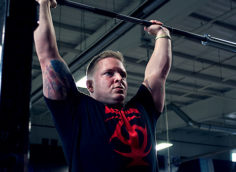Rack Pull-Ups
Want bigger lats? Try rack pull-ups.
Even though you're still doing a "vertical" pulling motion, there are some unique differences between rack pull-ups and normal pull-ups.
- With this variation, you get better lengthening of the lats via spinal flexion. Normally, spinal flexion is frowned upon because holding a neutral spine is important for movements like the squat and the deadlift. However, in order to fully lengthen the lats, spinal flexion is actually a requirement. To test this, simply bend over and touch your toes, trying to stretch your lats as much as possible. Now arch your back (spinal extension) and see what happens. The lats shorten.
- With the traditional chin-up or pull-up, we keep a certain amount of spinal extension mostly because the legs are behind us. With rack pull-ups, the legs are in front of the torso, allowing you to actually get the lats into a fully lengthened position. The two things we really want to take advantage of to maximize growth is to fully lengthen and shorten the muscles being worked. At the bottom of the rack pull-up, you can actually round the back and fully stretch the lats out.
- On the concentric (lifting up) portion of the exercise, the motion resembles the old Gironda sternum chin-up. Most people aren't strong enough to perform that movement to benefit from it, but with the rack pull-up, some aspects of it are obtainable.
- You'll begin the concentric portion by arching your spine and then continue to do so throughout to fully contract the lats. You should lean slightly away from the bar, which will also bring a lot of scapular retraction into play. This makes the rack pull-up more of a "complete" back movement than the traditional pull-up.
- To make it more difficult, have someone place a dumbbell or plate on the top of your legs. Straps are optional, but probably a good idea since we're trying to really overload the back here and not make this about grip work.
- At the top of the movement, the top of your legs should be parallel to the floor. If they're higher than that, then you'll end up with too much of a leverage advantage and they aren't as difficult. If they're lower than parallel, then achieving the shortening of the lats and scapular retraction aren't quite maximized.
- As a bonus, if regular pull-ups and chin-ups bother your cranky elbows, this variation will feel a thousand times better.




